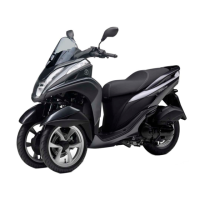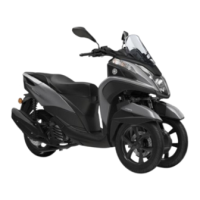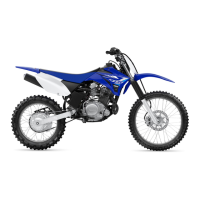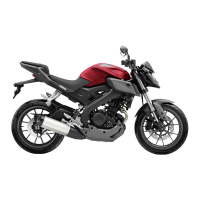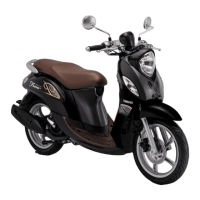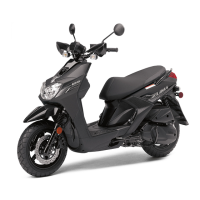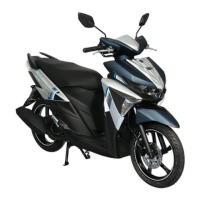Do you have a question about the Yamaha TRICITY 125 2016 and is the answer not in the manual?
Emphasizes owner's responsibility for safe operation and proper use of the vehicle.
Outlines pre-operation checks and vehicle maintenance for safe operation.
Details essential protective gear, including helmets, face shields, and clothing for rider safety.
Provides guidelines for safely adding cargo or accessories, focusing on weight distribution and stability.
Offers additional tips for safe riding, covering turns, braking on wet surfaces, and visibility.
Illustrates and labels components on the left side of the vehicle.
Illustrates and labels components on the right side of the vehicle.
Identifies and locates various controls and instrument panel elements.
Explains the function and positions of the main switch and steering lock mechanism.
Describes the meaning and function of various indicator and warning lights on the instrument panel.
Details the various displays and functions of the digital meter unit, including speedometer and fuel meter.
Identifies and explains the function of switches located on the left and right handlebars.
Describes the location and operation of the front brake lever.
Covers fuel tank cap operation, fuel filling instructions, and recommended fuel types.
Details the location, load limits, and usage precautions for the under-seat storage compartment.
Explains the location and function of the sidestand, including its relation to the ignition circuit cut-off system.
Describes how to use the auxiliary DC jack for powering accessories, including load limits.
Lists checks for fuel level, fuel line, and overflow hose before operating the vehicle.
Details checks for engine oil level and potential leaks before riding.
Outlines checks for coolant level and cooling system leaks.
Specifies checks for brake operation, fluid level, pads, and hydraulic system.
Lists checks for tire condition, tread depth, air pressure, and damage.
Details checks for the ignition circuit cut-off system's sidestand switch operation.
Provides step-by-step instructions for starting the vehicle's engine safely.
Guides the rider on how to safely move away from a stationary position.
Explains proper braking techniques, including avoiding sudden stops and handling wet surfaces.
Details the recommended procedures for the initial engine break-in period to ensure longevity.
Locates the owner's tool kit and explains its intended use for maintenance.
Guides on inspecting the spark plug's condition, gap, and electrode for engine health.
Explains how to check engine oil level and clean the oil strainer.
Details how to check the coolant level and what to do if it's low.
Covers tire inspection, air pressure, tread depth, and replacement guidelines.
Explains how to check front and rear brake pad wear using indicator grooves.
Describes how to check front and rear brake fluid levels and precautions.
Explains battery location, type, lead checks, and charging/storage procedures.
Guides on locating the fuse box and replacing blown fuses with correct amperage.
Introduces troubleshooting procedures for common engine and performance issues.
Advises on cleaning and maintaining matte finish parts to prevent damage.
General guidelines for cleaning the vehicle to maintain appearance and performance.
Provides instructions for short-term and long-term vehicle storage to prevent damage and corrosion.
Lists the physical measurements of the vehicle, such as length, width, and seat height.
Details engine specifications like displacement, bore, stroke, and compression ratio.
Specifies tire types, sizes, and air pressure recommendations.
Lists system voltage, ignition type, charging system, and battery details.
Explains the importance of recording vehicle identification, engine serial, and model label information.
Describes the vehicle's ECU data storage for diagnostics and research.
| Bore x Stroke | 52.4 mm x 57.9 mm |
|---|---|
| Lubrication System | Wet sump |
| Fuel System | Fuel Injection |
| Ignition System | TCI |
| Starter System | Electric |
| Transmission System | V-Belt Automatic |
| Front Suspension System | Telescopic fork |
| Front Travel | 90 mm |
| Rear Suspension System | Unit Swing |
| Front Brake | Hydraulic single disc, Ø 220 mm |
| Rear Brake | Hydraulic single disc, Ø 230 mm |
| Front Tyre | 90/80-14 |
| Overall Length | 1, 905 mm |
| Overall Width | 735 mm |
| Seat Height | 780 mm |
| Wheelbase | 1, 310 mm |
| Minimum Ground Clearance | 125 mm |
| Wet Weight | 152 kg |
| Engine Type | Liquid-cooled, 4-stroke, SOHC, 4-valve |
| Maximum Power | 9.0 kW (12.2 PS) @ 9, 000 rpm |
| Maximum Torque | 1.2 kg-m |
| Fuel Tank Capacity | 7.2 liters |
| Rear Tyre | 110/90-12 |
